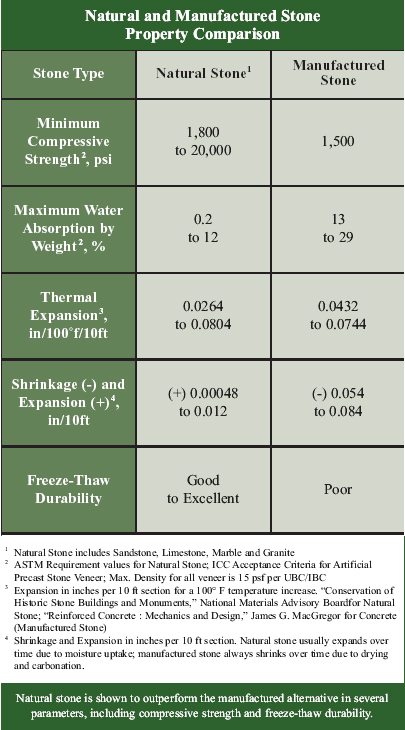Thin Brick and Thin-Cut Stone Take on Full-Dimension Masonry Products
Manufactured Stone
Manufactured stone is made by combining light-weight concrete and color pigments into a mold, and allowing it to cure. Some manufacturersuse quarried natural stones of varying sizes and shapes to make the molds, which are painted with iron oxide pigments, filled with the light-weight concrete, and subsequently vibrated to integrate surface coloration, and then textured. Once the mix is set, the manufactured stone is released from the mold and cured.
A disadvantage of the artificial coloring in manufactured stone is that dye lots can differ, resulting in noticeable variations in color among the flat stones themselves or between flat stones and corners, particularly on large projects on which hundreds of square feet of thin stone are used. In contrast to natural stone, the limited shapes and colors of manufactured stone may result in a noticeable repeating pattern.
While natural thin veneer is durable with very little water absorption,manufactured stone, on the other hand, is concrete based, and, therefore, is more porous. Once installed, it will need waterproofing, cleaningand maintenance. Unlike natural stone, manufactured stone's absorbent qualities increase its tendency to show efflorescence, which is a white, powdery deposit that can appear on the face of masonry walls. Normally, efflorescence is not harmful but serves as an indicator of excessive moisture exposure. Removing the moisture sources will eliminate efflorescence.
In a Rocky Mountain Masonry Institute comparison of natural stone to manufactured stone veneer, natural stone is shown to outperform the manufactured alternative in several parameters, including compressive strength and freeze-thaw durability. In addition, comparative data indicate that manufactured stone absorbs significantly more water per unit of weight than natural stone, and natural stone expands more over time while manufactured stone tends to shrink due to drying and carbonation.

Thin Brick
Real thin brick units are formed from shale or clay mined from the earth. Available in various sizes, colors and textures, thin bricks are approximately 3/8-to1-inch-thick. With face sizes comparable to conventional brick, thin brick, when installed, has the appearance of a traditional brick masonry wall. Many manufacturers fabricate thin bricks via an extrusion method: The clay mixture is forced through a die under high pressure, textured, and sliced into individual bricks. Extruded bricks tend to have a flat, "cookie-cutter" appearance that is akin to tile. At the other end of the spectrum are manufacturers that first fire the brick; it is tumbled and then cut into ½-inch slabs. The "tumbled" brick achieves a distinct and increasingly popular antique "weathered and worn" look. In commercial construction, thin brick units can be applied one at a time, or in large prefabricated panels.









